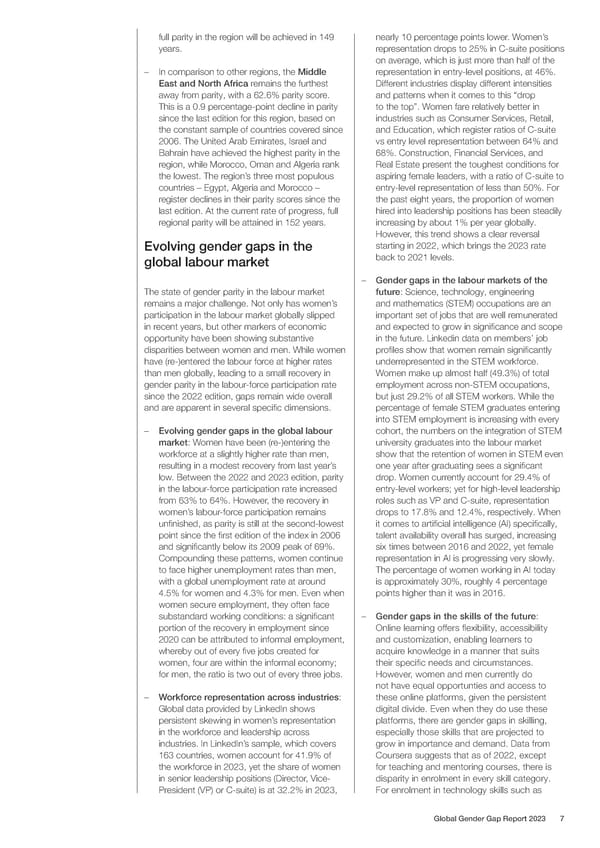full parity in the region will be achieved in 149 nearly 10 percentage points lower. Women’s years. representation drops to 25% in C-suite positions on average, which is just more than half of the – In comparison to other regions, the Middle representation in entry-level positions, at 46%. East and North Africa remains the furthest Different industries display different intensities away from parity, with a 62.6% parity score. and patterns when it comes to this “drop This is a 0.9 percentage-point decline in parity to the top”. Women fare relatively better in since the last edition for this region, based on industries such as Consumer Services, Retail, the constant sample of countries covered since and Education, which register ratios of C-suite 2006. The United Arab Emirates, Israel and vs entry level representation between 64% and Bahrain have achieved the highest parity in the 68%. Construction, Financial Services, and region, while Morocco, Oman and Algeria rank Real Estate present the toughest conditions for the lowest. The region’s three most populous aspiring female leaders, with a ratio of C-suite to countries – Egypt, Algeria and Morocco – entry-level representation of less than 50%. For register declines in their parity scores since the the past eight years, the proportion of women last edition. At the current rate of progress, full hired into leadership positions has been steadily regional parity will be attained in 152 years. increasing by about 1% per year globally. However, this trend shows a clear reversal Evolving gender gaps in the starting in 2022, which brings the 2023 rate global labour market back to 2021 levels. – Gender gaps in the labour markets of the The state of gender parity in the labour market future: Science, technology, engineering remains a major challenge. Not only has women’s and mathematics (STEM) occupations are an participation in the labour market globally slipped important set of jobs that are well remunerated in recent years, but other markers of economic and expected to grow in signi昀椀cance and scope opportunity have been showing substantive in the future. Linkedin data on members’ job disparities between women and men. While women pro昀椀les show that women remain signi昀椀cantly have (re-)entered the labour force at higher rates underrepresented in the STEM workforce. than men globally, leading to a small recovery in Women make up almost half (49.3%) of total gender parity in the labour-force participation rate employment across non-STEM occupations, since the 2022 edition, gaps remain wide overall but just 29.2% of all STEM workers. While the and are apparent in several speci昀椀c dimensions. percentage of female STEM graduates entering into STEM employment is increasing with every – Evolving gender gaps in the global labour cohort, the numbers on the integration of STEM market: Women have been (re-)entering the university graduates into the labour market workforce at a slightly higher rate than men, show that the retention of women in STEM even resulting in a modest recovery from last year’s one year after graduating sees a signi昀椀cant low. Between the 2022 and 2023 edition, parity drop. Women currently account for 29.4% of in the labour-force participation rate increased entry-level workers; yet for high-level leadership from 63% to 64%. However, the recovery in roles such as VP and C-suite, representation women’s labour-force participation remains drops to 17.8% and 12.4%, respectively. When un昀椀nished, as parity is still at the second-lowest it comes to arti昀椀cial intelligence (AI) speci昀椀cally, point since the 昀椀rst edition of the index in 2006 talent availability overall has surged, increasing and signi昀椀cantly below its 2009 peak of 69%. six times between 2016 and 2022, yet female Compounding these patterns, women continue representation in AI is progressing very slowly. to face higher unemployment rates than men, The percentage of women working in AI today with a global unemployment rate at around is approximately 30%, roughly 4 percentage 4.5% for women and 4.3% for men. Even when points higher than it was in 2016. women secure employment, they often face substandard working conditions: a signi昀椀cant – Gender gaps in the skills of the future: portion of the recovery in employment since Online learning offers 昀氀exibility, accessibility 2020 can be attributed to informal employment, and customization, enabling learners to whereby out of every 昀椀ve jobs created for acquire knowledge in a manner that suits women, four are within the informal economy; their speci昀椀c needs and circumstances. for men, the ratio is two out of every three jobs. However, women and men currently do not have equal opportunties and access to – Workforce representation across industries: these online platforms, given the persistent Global data provided by LinkedIn shows digital divide. Even when they do use these persistent skewing in women’s representation platforms, there are gender gaps in skilling, in the workforce and leadership across especially those skills that are projected to industries. In LinkedIn’s sample, which covers grow in importance and demand. Data from 163 countries, women account for 41.9% of Coursera suggests that as of 2022, except the workforce in 2023, yet the share of women for teaching and mentoring courses, there is in senior leadership positions (Director, Vice- disparity in enrolment in every skill category. President (VP) or C-suite) is at 32.2% in 2023, For enrolment in technology skills such as Global Gender Gap Report 2023 7
 Global Gender Gap Report 2023 Page 6 Page 8
Global Gender Gap Report 2023 Page 6 Page 8